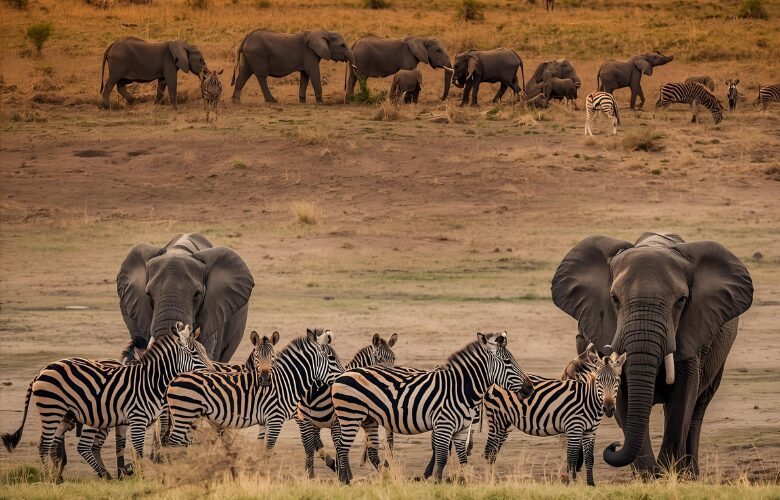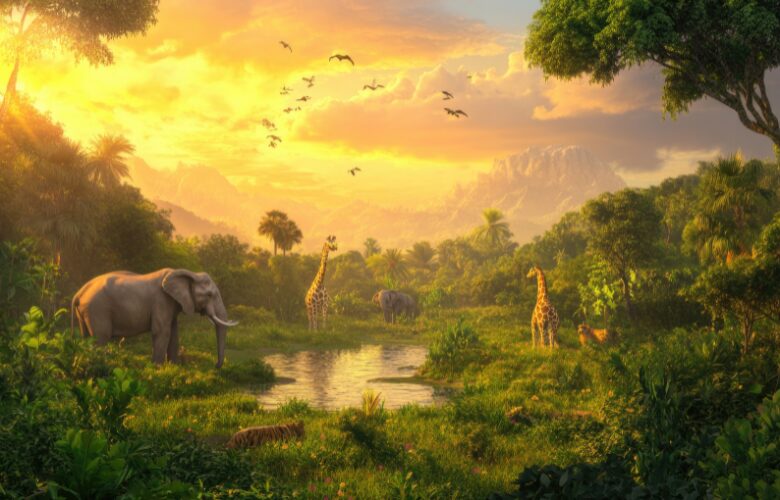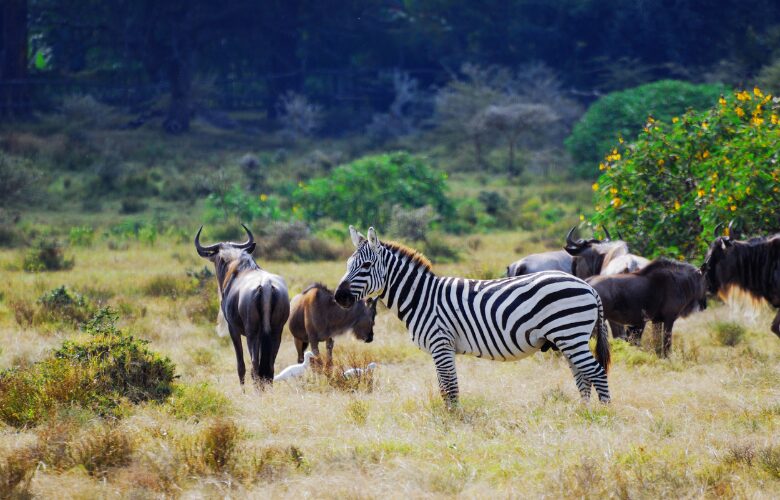Best places to see wildlife in West Africa. If you’ve ever dreamed of hearing an elephant trumpet across the savannah or watching a troop of chimpanzees swing through the treetops, Africa is calling. Not just the well-trodden safaris of the east and south. Hidden in the heart of West Africa are landscapes where wildlife still roams free, waiting to be discovered by travelers who crave authenticity over crowds.
While East Africa may steal the spotlight, the best places to see wildlife in Africa aren’t limited to the Serengeti or Kruger. West Africa is a region of untamed beauty, home to elephants, hippos, lions, and vibrant birdlife all set against backdrops of rainforests, golden plains, and winding rivers.
Let’s journey together through some of West Africa’s most stunning wildlife destinations, where adventure meets serenity and every roar, rustle, and ripple tells a story of the wild.

Mole National Park (Ghana)
When it comes to wildlife experiences in West Africa, Mole National Park is often the first name that comes to mind. Stretching across 4,800 square kilometers, this is Ghana’s largest and most celebrated wildlife reserve and for good reason.
Imagine standing on a sunlit trail as a herd of elephants wanders past, close enough to hear their gentle rumble. From graceful antelopes and warthogs to over 300 bird species, Mole offers an authentic safari without the rush of big tour groups.
Best time to visit: Between November and April, when animals gather at waterholes and the grass is low for easy viewing.
Travel tip: Stay at Mole Motel or Zaina Lodge for sweeping views of the savannah.
Gola Rainforest National Park (Sierra Leone)
In the lush corners of Sierra Leone, the Gola Rainforest National Park protects one of the most biodiverse ecosystems in Africa. Nicknamed the “Green Heart of West Africa,” Gola is a haven for nature lovers seeking something wild, untouched, and real.
Here, you can track chimpanzees, spot pygmy hippos, or simply listen to the chatter of tropical birds echoing through the forest canopy. It’s not your typical safari; it’s a deep-forest encounter with Africa’s natural rhythm.
Why it’s special: Few places offer this much biodiversity in such a peaceful setting.
Best time to visit: December to April for drier, easier trekking conditions.
Pendjari National Park (Benin)
For those seeking the best places to see wildlife in West Africa without the crowds, Pendjari National Park in northern Benin is a treasure waiting to be explored. Part of the vast W-Arly-Pendjari complex, this UNESCO World Heritage Site is home to lions, cheetahs, elephants, hippos, and over 460 species of birds.
The park’s landscapes shift from golden grasslands to dense woodland, creating a painter’s palette of life and color. You’ll find guided safaris here that rival those of Eastern Africa but with a personal, off-the-beaten-path touch.
When to go: November through April, during the dry season, when animals cluster near rivers and watering holes.
Niokolo-Koba National Park (Senegal)
Step into Niokolo-Koba National Park, a vast UNESCO World Heritage Site in southeastern Senegal that feels like Africa at its purest. With over 9,000 square kilometers of protected land, it’s home to an impressive range of species from lions, leopards, and hippos to Derby elands and crocodiles.
Here, safaris are slower, quieter, and more immersive. Whether you explore on foot or by riverboat, every moment feels like a step back in time into an Africa that still beats wild and free.
Insider tip: Pair your visit with a trip along the Gambia River for birdwatching and unforgettable sunsets.
Taï National Park (Côte d’Ivoire)
Few places capture the magic of Africa’s forests like Taï National Park in Côte d’Ivoire. This UNESCO-listed reserve is one of the last major remnants of primary rainforest in West Africa: A lush, living cathedral of trees, vines, and rare creatures.
Here, you can encounter chimpanzees, forest elephants, and pygmy hippos, along with countless other animals that make Taï a biodiversity hotspot. For wildlife lovers, it’s a chance to explore one of the most vital ecosystems on Earth. One that feels almost otherworldly in its beauty.
Why visit: It’s a paradise for eco-travelers and anyone passionate about conservation.
Outamba-Kilimi National Park (Sierra Leone)
A blend of rainforest and savannah, great for spotting elephants and monkeys. Tucked away in Sierra Leone’s northern region, Outamba-Kilimi National Park is a captivating blend of savannah grasslands and tropical rainforest, offering a unique mix of landscapes and wildlife.
Here, elephants meander along riverbanks, hippos splash in shallow waters, and chimpanzees chatter from treetop to treetop. The park is home to over 200 bird species, making it a hidden paradise for birdwatchers and photographers.
What makes Outamba-Kilimi special is its peaceful atmosphere. It’s far less commercialized than many other African parks, giving you the chance to experience nature’s magic almost entirely on your own.
Best time to visit: November to April, during the dry season when animals are easier to spot.
Pro tip: Visit local villages near the park to experience Sierra Leone’s warm hospitality and culture alongside its wildlife.
Kainji Lake National Park (Nigeria)
Nigeria’s oldest national park, known for crocodiles and diverse bird life. Located in northwestern Nigeria, Kainji Lake National Park is not just Nigeria’s first national park. It’s also one of the country’s most significant conservation areas.
The park spans over 5,300 square kilometers, encompassing rolling hills, river valleys, and dense woodland. Wildlife enthusiasts can spot elephants, crocodiles, antelopes, warthogs, and countless bird species, especially around the Oli River and Kainji Lake.
For those interested in a deeper experience, the park also protects historic and cultural heritage sites, offering a well-rounded adventure that combines wildlife, nature, and culture.
Why it’s worth visiting: Its diversity both in wildlife and ecosystems offers one of the most rewarding safari experiences in West Africa.
Best time to visit: December to May, when vegetation is thinner and animals come out to the open plains.
Sapo National Park (Liberia)

A remote rainforest teeming with life perfect for those who crave true wilderness. Deep in the heart of Liberia lies Sapo National Park, a place that truly embodies the phrase “untouched wilderness.” As Liberia’s largest protected area and one of the last intact rainforests in West Africa, Sapo is home to an astonishing variety of life.
From forest elephants and African golden cats to pygmy hippos, chimpanzees, and hundreds of rare plant species, Sapo offers a sense of exploration that feels raw and real. The park’s dense canopy and remote setting mean it’s best suited for adventurous travelers; Those who don’t mind trading comfort for the thrill of discovery.
Why it’s special: Sapo is part of the Upper Guinean Rainforest, one of the most biodiverse ecosystems on Earth.
Best time to visit: December to March for drier paths and better access to wildlife areas.
Travel Tips for Wildlife Lovers
Seeing wildlife in Africa is about more than ticking animals off a list. It’s about connection, respect, and responsibility. Here are a few quick tips to make your trip unforgettable:
- Travel responsibly: Support eco-lodges and local guides who prioritize conservation.
- Pack smart: Bring binoculars, a camera, sunscreen, and insect repellent.
- Be patient: The best sightings often happen when you least expect them.
- Respect wildlife: Keep a safe distance and never feed animals.
- Learn local culture: A simple greeting in the local language can open hearts and doors.
Africa’s wildlife doesn’t exist only in the famous game parks of the east or south. In the west, you’ll find a quieter, more soulful kind of safari, one that invites you to slow down, breathe, and truly connect with nature.
From the elephant herds of Mole to the rainforest whispers of Taï, West Africa is one of the best places to see wildlife for travelers who seek authenticity and wonder. Every path here tells a story of resilience, of wild beauty, and of the delicate bond between humans and the natural world.
So, what are you waiting for? Pack your sense of adventure, follow the call of the wild, and let Candr Outdoors be your guide to discovering the untamed magic of West Africa.
Table of Contents
